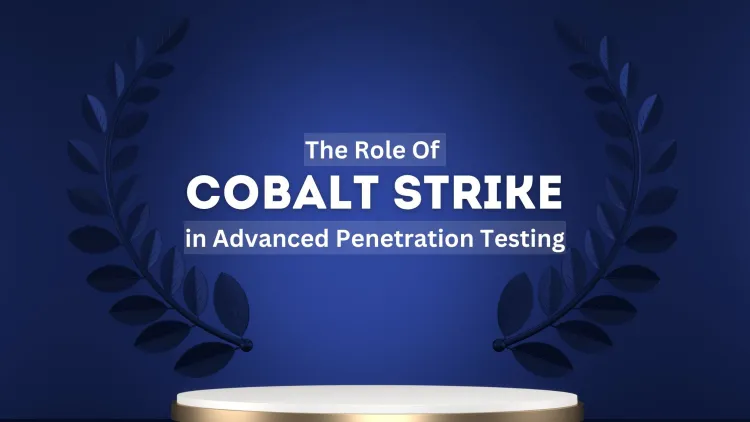The Role of Cobalt Strike in Advanced Penetration Testing | Overview, Features, and Why Ethical Hackers Use It
Cobalt Strike is an essential tool for ethical hackers and penetration testers who need to simulate advanced cyberattacks and test the security of systems in a realistic manner. Its powerful features, including post-exploitation tools, phishing capabilities, and C2 management, make it ideal for conducting in-depth security assessments. By using Cobalt Strike, organizations can better prepare for and defend against real-world cyber threats.

In the world of cybersecurity and penetration testing, having the right tools to simulate real-world attacks and exploit vulnerabilities is critical. Cobalt Strike is one such tool that has gained immense popularity among ethical hackers and security professionals for conducting advanced penetration tests and simulating sophisticated cyberattacks. Cobalt Strike provides an array of powerful features that enable penetration testers to emulate advanced threats and assess the security of systems thoroughly. In this blog, we will explore what Cobalt Strike is, its key features, how it works, and why it is considered a top choice for penetration testers and red teams.
What is Cobalt Strike?
Cobalt Strike is a commercial penetration testing tool designed for red teams and ethical hackers to simulate advanced cyberattacks. It provides a powerful platform for offensive security by mimicking the tactics, techniques, and procedures (TTPs) of real-world adversaries. Cobalt Strike enables attackers (in a controlled, ethical manner) to identify weaknesses and vulnerabilities within a system and network by performing post-exploitation activities, executing phishing attacks, and managing compromised systems.
Cobalt Strike is primarily used to test and assess the robustness of network defenses by simulating targeted attacks, enabling organizations to improve their security posture and prepare for actual cyber threats. Its flexibility and range of tools make it a highly effective option for penetration testing and simulating Advanced Persistent Threats (APTs).
Why Ethical Hackers Use Cobalt Strike
Cobalt Strike is favored by ethical hackers for several reasons. Its features make it an invaluable tool for penetration testers and red teams to simulate advanced attacks, assess vulnerabilities, and strengthen security measures. Below are some of the main reasons why ethical hackers rely on Cobalt Strike:
1. Advanced Post-Exploitation Capabilities
Cobalt Strike allows penetration testers to perform in-depth post-exploitation activities, providing tools to elevate privileges, move laterally across networks, and maintain persistence within compromised environments. These post-exploitation capabilities are crucial for understanding how attackers can exploit vulnerabilities once they gain access to a system.
2. Simulating APTs
Cobalt Strike is known for its ability to emulate Advanced Persistent Threats (APTs), which are often sophisticated, long-term attacks used by cybercriminals and state-sponsored actors. By simulating these types of attacks, ethical hackers can test their defenses against highly skilled attackers, providing a realistic assessment of system vulnerabilities.
3. Red Team Collaboration
As a red team tool, Cobalt Strike promotes collaboration among different penetration testers during an engagement. It supports multiple users working together to simulate coordinated attacks, enabling real-time collaboration and enhancing the overall testing effectiveness.
4. Social Engineering Tools
Cobalt Strike includes integrated social engineering tools that allow penetration testers to conduct phishing attacks and credential harvesting. By simulating phishing emails, fake login pages, and other social engineering tactics, ethical hackers can assess how employees interact with malicious content and how easily they can be deceived.
5. Flexible Payload Generation
Cobalt Strike provides advanced capabilities for creating custom payloads that can be used to exploit vulnerabilities in a network. These payloads can be configured to bypass antivirus software and other defense mechanisms, giving testers the ability to deliver their attack payloads without detection.
Key Features of Cobalt Strike
Cobalt Strike is packed with an array of powerful features that allow penetration testers to carry out highly advanced and realistic attack simulations. Some of the key features include:
1. Beacon
The core component of Cobalt Strike is Beacon, a versatile and highly customizable payload that facilitates command and control (C2) communications. Beacon can be configured to execute a variety of post-exploitation actions, including privilege escalation, data exfiltration, lateral movement, and persistence. It can also evade detection by using techniques like HTTP/S, DNS, and SMB for communication.
2. Post-Exploitation Tools
Cobalt Strike includes an extensive set of tools for performing post-exploitation tasks, such as:
- Privilege escalation: Granting attackers higher levels of access on compromised systems.
- Lateral movement: Allowing attackers to move from one compromised system to another within a network.
- Persistence: Enabling attackers to maintain access to compromised systems over time.
- Data exfiltration: Extracting sensitive information from compromised systems or networks.
3. Malleable C2 Profiles
Cobalt Strike offers Malleable C2 Profiles, which allow users to modify the communication between the attacker's system and the compromised host. These profiles enable ethical hackers to make the attack traffic appear more like legitimate traffic, thus evading detection by network defense systems, such as firewalls and intrusion detection systems (IDS).
4. Collaboration and Teamwork
Cobalt Strike supports collaboration among multiple red team members during an engagement. Team members can share sessions, data, and tactics in real time, increasing efficiency and effectiveness. This feature is particularly beneficial for larger-scale assessments and red team exercises.
5. Phishing and Social Engineering
Cobalt Strike provides phishing capabilities, such as creating fake websites, sending spear-phishing emails, and creating malicious documents. These tools help ethical hackers simulate real-world social engineering attacks, which are often the starting point for many cyberattacks.
6. Command and Control Server (C2)
Cobalt Strike includes an integrated C2 server, allowing penetration testers to control and manage compromised systems. The C2 server communicates with the compromised systems (via Beacon), providing a platform for attackers to execute commands, retrieve information, and control the network.
How Cobalt Strike Works
Cobalt Strike operates by allowing penetration testers to simulate sophisticated cyberattacks on a network or system. Here’s how the tool typically works in a penetration test:
-
Initial Access: Ethical hackers use phishing or exploits to gain initial access to a target system. Cobalt Strike helps deliver payloads that establish a command-and-control channel with the compromised system.
-
Beacon Setup: After gaining access, Cobalt Strike deploys Beacon, a custom payload that establishes an encrypted communication channel between the compromised system and the attacker. Beacon allows the attacker to perform actions like privilege escalation, data exfiltration, and lateral movement across the network.
-
Post-Exploitation: Once Beacon is established, ethical hackers perform post-exploitation tasks such as moving laterally to other systems, escalating privileges, and maintaining persistence. The attack can be simulated as a multi-phase attack campaign to test how well the organization’s defenses can detect and mitigate it.
-
Simulate APTs: Cobalt Strike allows ethical hackers to emulate APT techniques, such as long-term persistence, data exfiltration, and covert command-and-control communication, mimicking real-world cyberattacks by advanced adversaries.
-
Final Report: After the engagement, Cobalt Strike can be used to compile findings into a detailed report that highlights vulnerabilities, successful exploits, and remediation recommendations.
Benefits of Cobalt Strike for Ethical Hackers
1. Simulate Real-World Attacks
Cobalt Strike enables ethical hackers to simulate advanced attacks, including those used by APT groups, giving organizations a realistic understanding of their security posture.
2. Evade Detection
Cobalt Strike’s malleable C2 profiles and covert communication channels make it effective in evading detection by security systems, including IDS/IPS and firewalls.
3. Advanced Post-Exploitation
The tool provides powerful post-exploitation capabilities, helping ethical hackers identify critical vulnerabilities and system weaknesses once access has been gained.
4. Red Team Collaboration
Cobalt Strike supports team-based testing, making it ideal for red teams working together to simulate advanced attacks.
5. Scalable for Complex Tests
Cobalt Strike can be used for large-scale penetration tests, making it suitable for testing large networks and complex systems.
Best Practices for Using Cobalt Strike
- Obtain Explicit Permission: Always ensure that you have written authorization from the target organization before using Cobalt Strike in any penetration testing scenario.
- Use in a Controlled Environment: Cobalt Strike should only be used in a controlled environment or lab for testing, as its powerful capabilities can cause disruptions in production environments.
- Stay Updated: Regularly update Cobalt Strike to ensure you are using the latest features and security patches.
- Document Findings Thoroughly: After completing a penetration test with Cobalt Strike, document your findings in detail to provide the organization with actionable insights.
Conclusion
Cobalt Strike is an indispensable tool for ethical hackers, penetration testers, and red teams. Its powerful capabilities for simulating real-world attacks, performing advanced post-exploitation activities, and collaborating in red team exercises make it a vital tool for assessing the effectiveness of security defenses. By using Cobalt Strike, organizations can identify vulnerabilities and weaknesses in their security infrastructure, ensuring they are better prepared for advanced cyberattacks and malicious actors.
FAQs
-
What is Cobalt Strike? Cobalt Strike is a commercial penetration testing tool used for simulating advanced cyberattacks and testing the security of networks and systems.
-
What are the main features of Cobalt Strike? Cobalt Strike includes advanced post-exploitation tools, malleable C2 profiles, phishing capabilities, lateral movement, and privilege escalation tools.
-
Who uses Cobalt Strike? Ethical hackers, red teams, penetration testers, and security professionals use Cobalt Strike for conducting advanced security assessments.
-
Can Cobalt Strike evade security detection? Yes, Cobalt Strike’s malleable C2 profiles and covert communication techniques help it evade detection by firewalls, IDS, and other security systems.
-
Is Cobalt Strike used for ethical hacking? Yes, Cobalt Strike is used by ethical hackers for legal, authorized penetration testing and security assessments.
-
What is the Beacon in Cobalt Strike? Beacon is a payload used in Cobalt Strike that enables command and control (C2) communications between the attacker and compromised systems.
-
Can Cobalt Strike be used to simulate Advanced Persistent Threats (APTs)? Yes, Cobalt Strike is specifically designed to simulate APT attacks by emulating the tactics, techniques, and procedures of real-world cybercriminals.
-
Is Cobalt Strike suitable for beginners? While Cobalt Strike is a powerful tool, it is generally recommended for experienced penetration testers due to its complexity and advanced features.
-
Can Cobalt Strike integrate with other tools? Yes, Cobalt Strike can be integrated with tools like Metasploit for enhanced penetration testing capabilities.
-
How do I learn to use Cobalt Strike? Cobalt Strike offers training and documentation to help users get started. There are also many community resources and tutorials available online.












![Top 10 Ethical Hackers in the World [2025]](https://www.webasha.com/blog/uploads/images/202408/image_100x75_66c2f983c207b.webp)

![[2025] Top 100+ VAPT Interview Questions and Answers](https://www.webasha.com/blog/uploads/images/image_100x75_6512b1e4b64f7.jpg)









